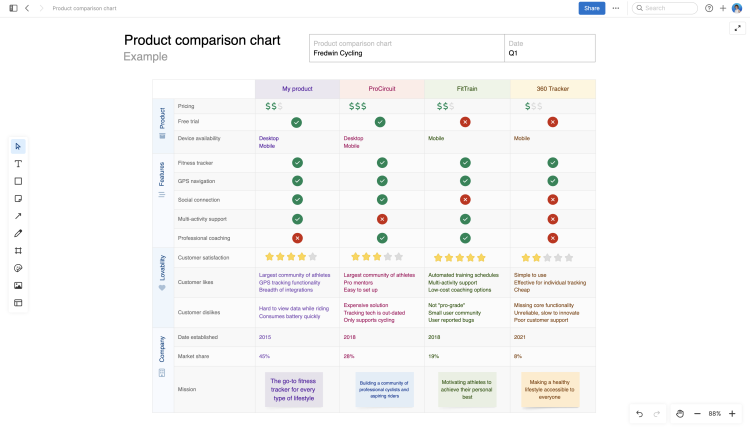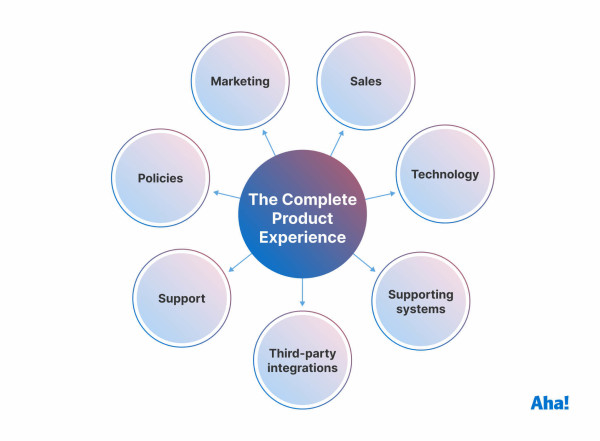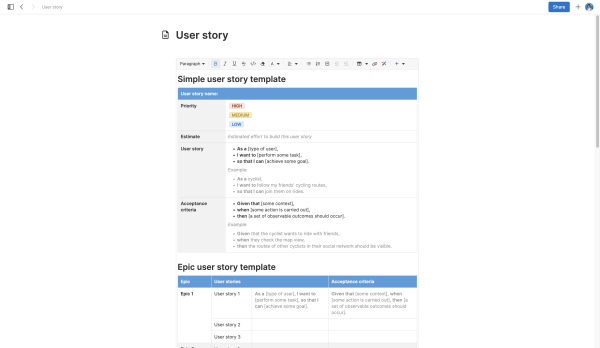Product differentiation explained: A guide and strategies for product managers
Last updated: February 2025
What makes a product stand apart from the crowd? This is the fundamental question to ask when considering how to achieve effective product differentiation.
Product differentiation is how you make your product stand out to prospects and customers as they consider all their options. It highlights the unique features and value you offer compared to competitors and helps target audiences see why yours is the right solution.
You may hear some people refer to this as your unique selling proposition (USP). No matter what you call it, successful product differentiation requires that you define the special benefits of what you are selling and communicate those benefits to potential customers. The goal is not to focus on competitors but instead highlight distinguishing characteristics of your offering and why customers should choose you.
As you think about product differentiation, try visualizing how your product compares to others. Use a simple product comparison chart template to clarify the unique value you offer.
Compare products on a whiteboard in Aha! software— try it for free.

Use the following links to jump ahead to a specific section:
Why is product differentiation important?
Buyers have more options than ever before. When faced with so many choices, customers can quickly become overwhelmed. Instead of spending extensive time researching each product, they may simply buy the one with the most name recognition or the lowest price. Or they may even walk away without making any purchase at all. This is why defining and communicating the unique benefits of your product is essential — you are educating customers on exactly what you are offering, how it can help them, and why they should buy it.
Having a strong product differentiation strategy allows you to create a competitive advantage. This means that your target market views your product or service as superior to what your competitors are selling. When prospective customers understand what makes your product different (and how it will solve their problems), they are more likely to be interested in trying it. In turn, this can lead to increased sales, greater brand loyalty, and long-term growth for your company.
Related:
Types of product differentiation
Customers make purchasing decisions based on a variety of factors. Before examining the specific reasons that buyers tend to choose one product over another, let's take a look at the three main types of product differentiation: vertical, horizontal, and mixed product differentiation. Breaking product differentiation into these three categories can help explain why customers decide to buy one product instead of another.
Let's take a closer look at each type:
Vertical product differentiation gives customers an objective way to make purchasing decisions. After reviewing their options, customers rank each one according to price or perceived quality. Buyers will typically choose the item that scores the highest. Examples of vertical differentiation include name brand or generic products and computers with faster or slower processing speeds.
Horizontal product differentiation offers buyers a more subjective way to choose a product. When the options are similar in terms of price and quality, customers base their selection on taste or personal preference. Examples of horizontal differentiation include soft drink brands and products with different color or flavor options.
Mixed product differentiation describes a hybrid approach to selecting a product — based on both quantitative and qualitative factors. Customers may rank products based on price and quality while also considering more subjective measures such as color or design. Examples of mixed differentiation include purchasing a house or car. Buyers weigh a variety of factors, including price, quality, branding, and appearance.
Key strategies to achieve product differentiation
You do not want your product to be different just for the sake of being different. Instead, consider what matters most to your customers. Gain a deep understanding of who they are, what they want, and how you can solve their problems. You should also thoroughly research your competition so you know about the alternatives that are available and the benefits they offer. When you truly grasp what your customers need, you can build a unique product that they love.
Here are some of the specific ways you can differentiate your product:
Benefits | What value can customers expect to gain from using your product compared to others? What problem is the product going to solve? How is it going to make people's lives easier and better? For example, your product may be the only solution offering a time-saving mobile app or the ability to integrate with tools that customers already use. |
Design | Does your product look different or function better than others? For example, a product that is sleek and provides a simple user experience is more appealing than one that is clunky or dated. Think about the modern design sensibility of the Nest thermostat. Instead of copying the rectangular shape of other thermostats, the company opted for a circle with an easy-to-read, color-changing display. Another example is Strava, the running and cycling tracking app. Its design allows users to track and quantify workout data while also building a social community. When you provide innovative designs and interfaces, customers will be more likely to connect with your product. |
Price | Is your product priced lower or higher than your competitors? The price of your offering should reflect the overall value that you provide. You can justify a higher price if customers recognize that your product offers unsurpassed quality — this is price differentiation in action. It is how a luxury brand like Ferrari can command a top asking price for their cars. Set too low of a price, however, and customers may not see your product as truly valuable. |
Quality | Does your product simply work better than your competitors’ products? Can users expect the product to last longer than other products? Selling a product with superior construction and dependability can provide a strong competitive advantage. Take Patagonia, the clothing and outdoor goods company. Many buyers opt for their jackets and boots because of the company's reputation for making durable products that last many years. |
Customer service | Does your company offer a Complete Product Experience (CPE) — including superior customer service? The features of your product may be similar to others in many ways, but you can achieve successful product differentiation by assembling a stand-out support team and earning a reputation for being ultra-responsive to customers' needs, requests, and ideas. For example, the #1 core value for Zappos is "deliver wow through service" and they succeed even though they do not always have the lowest price. A customer who orders shoes by midnight may receive their package the next morning. This emphasis on customer service pays off — judging by the fact that 75 percent of their sales are reportedly from repeat customers. |
Of course, you always need to take into account your overall product vision — the "why" behind what you are building. This will guide you as you determine how you want to differentiate your product and deliver value to customers.
Related:
Who is responsible for product differentiation?
Product teams are typically responsible for defining the differentiation strategy. As the leader of the cross-functional product team, product managers work closely with teammates in marketing, sales, engineering, and customer support to clarify what makes the product unique, how it differs from others in the market, and how customers will benefit.
Then the marketing team drafts the product positioning and messaging. While a positioning document captures the unique selling points of your product or service for internal teams, messaging consists of the key points you will communicate to customers in order to differentiate your product. Members of product marketing and content marketing teams are usually responsible for drafting product positioning and messaging, respectively.
Although product and marketing teams play the biggest role in product differentiation, everyone in the organization is responsible for identifying new differentiation opportunities. This is because your product is more than an assortment of features — you are offering a complete experience for customers, from when they first learn about your offering to when they speak to the support team after making a purchase. Every touchpoint that people experience as they interact with your company is an opportunity to set yourself apart from your competitors and deliver more value to users.
How to define a product differentiation strategy
Differentiating your product or service requires serious thought and research. The way you differentiate should not be an arbitrary decision or a reactive response to whatever your competitors are doing. You have to consider the overall company strategy, the product goals and initiatives, and what your customers truly need.
Here are some quick tips for getting started on defining a differentiation strategy:
Research The more information you gather about competitors and the market, the better able you will be to offer something unique. What features are your competitors offering? At what price points? What trends do you notice in the industry? Understanding the market means studying the competitive landscape and trying similar products to see what they offer.
Empathize Building a better product requires deeply knowing what your target customers value and internalizing their struggles. Define the problems they are trying to solve and try to feel their pain as your own. Then compare these customer needs to the products that are currently on the market — identifying areas where there are still unmet needs or unresolved problems.
Select Now it is time to decide how you want to differentiate your product. Start by listing features that your competitors do not offer. You can also list other ways you can set your product apart, such as lower pricing or superb customer service. From your list, choose one to three characteristics that your target customers value most deeply — this will be the foundation of your differentiation strategy.
Commit Of those characteristics that you identified in the previous step, which are aligned with your company and product goals? Add these to your product roadmap and communicate your differentiation strategy to the rest of the team.
Remember to revisit your strategy from time to time. As customers preferences evolve and the competitive landscape shifts, you will need to make sure that the way you are distinguishing your product still makes sense for your target audience and the broader company goals.


